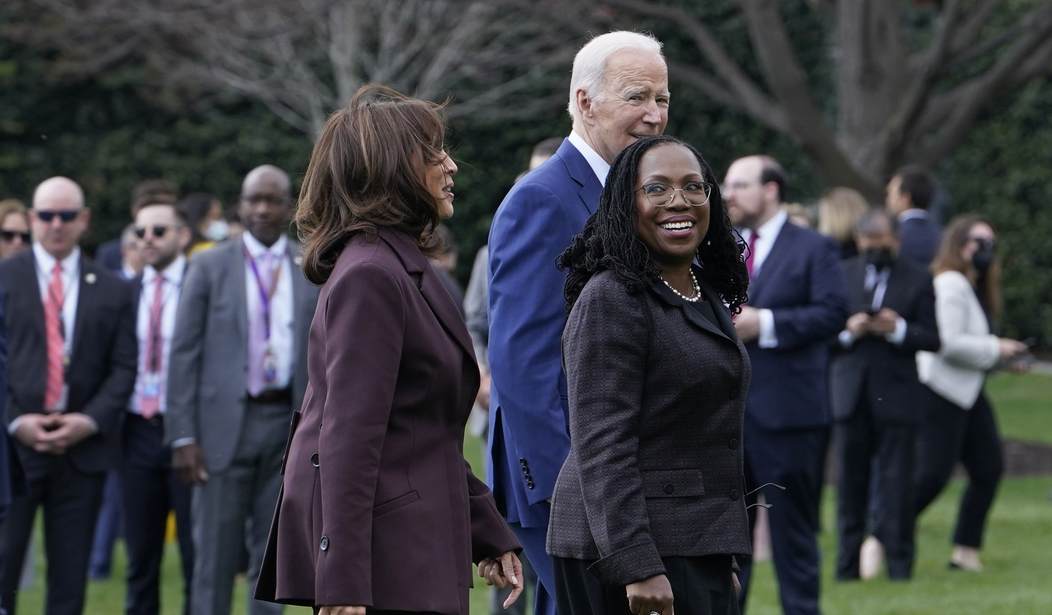Tuesday, the US Supreme Court heard arguments in a case called Merrill v. Milligan. This is a “voting rights” case coming out of Alabama that pits the ability of the state legislature to draw congressional districts against the racial spoils system favored by the left. The case is critical to staunching the racial balkanization of the nation, and it also gave some insight on what to expect from Joe Biden’s Supreme Court selection and why, if the Republicans regain control of the Senate, it is critical to the future of the nation that he gets no more court appointments.
Background
When Alabama’s legislature created new Congressional districts based on the 2020 Census, they left the 1990 lines basically unchanged. This resulted in one “majority-minority” district and six districts that didn’t sort voters out by race. When the map was announced, numerous groups sued, claiming that a decrease in the percentage of non-Hispanic Whites required a second “majority-minority” district. The 6+1 formula, the plaintiffs claimed, violated Section 2 of the Voting Rights Act of 1965 and the Fourteenth Amendment.
Three separate suits were filed. Two were heard by a three-judge panel — Judges Stanley Marcus (Reagan), Terry F. Moorer (Trump), and Anna M. Manasco (Trump) — the third was heard by Mansco alone. On January 24, the courts enjoined Alabama from implementing its map.
A panel of three federal judges threw out Alabama’s congressional map on Monday and ordered state lawmakers to draw a new one with two, rather than just one, districts that are likely to elect Black representatives.
The map that Alabama’s Republican-majority State Legislature adopted last fall drew one of the state’s seven congressional districts with a majority of Black voters. The court ruled that with Alabama’s Black population of 27 percent, the state must allot two districts with either Black majorities or “in which Black voters otherwise have an opportunity to elect a representative of their choice.”
“Black voters have less opportunity than other Alabamians to elect candidates of their choice to Congress,” the panel of judges wrote.
Alabama District Court Merrill v. Milligan by streiff at redstate on Scribd
Alabama appealed to the US Supreme Court (Alabama Appeals the Rejection of Its Redistricting Map and the Left May Get More Than It Wanted or Expected). On February 5, SCOTUS issued a stay of the district court injunctions. The vote was 5-4, with Chief Justice John Roberts joining the liberals (The Supreme Court Drops the Hammer on Democrat Redistricting Games and Sets up a Coming Death Blow and Why We Shouldn’t Fear Chief Justice John Roberts as More Clouds Loom Over the Future of Racial Gerrymanders and the Voting Rights Act).
SCOTUS decision to hear the appeal of Merrill v. Milligan by streiff on Scribd
The Stakes
In my view, one of the greatest threats to the American Experiment is our elites abandoning the idea of American identity in favor of racial and ethnic tribalism. Noting is a more straightforward example of this than the idea that the interests of Black or Hispanic voters can only be met by packing them into a congressional district and guaranteeing the election of a member of Congress of that race or ethnicity. It is the leading edge of the Diversity, Inclusion, and Equity bullsh** that is destroying everything it touches. It is doubly dangerous because this racial bean-counting and endless series of lawsuits tend to force state legislatures out of the process in favor of unelected and unaccountable bureaucracies in the form of “non-partisan commissions.” This entire impulse is an affront to our history, the Constitution, and a free people. Here is an interview in “Harvard Law Today” that gives an insight into what the wrong side of this argument wants.
HLT: How are the lines of congressional districts typically drawn and by whom?
[Harvard Law Professor Nicholas] Stephanopoulos: As in Alabama, the norm is that state legislators draw congressional districts. Because state legislators are about the last people who should be entrusted with redistricting, an increasing number of states have transferred line-drawing authority to independent commissions. The House of Representatives also recently passed a bill (which foundered on the Senate filibuster) that would have required all states to use commissions for congressional redistricting.
HLT: Alabama officials argue that the Supreme Court should permanently reinstate the electoral map originally drawn by the state legislature. Can you summarize their arguments?
Stephanopoulos: Their argument is a frontal attack on the doctrinal framework that courts have used for almost forty years to decide Section 2 cases. They want the baseline relative to which the enacted plan is evaluated to be the usual outcome of a race-blind redistricting process. That usual outcome would be determined using computer simulations that ignore race but satisfy all nonracial criteria. Here, this approach would favor Alabama because the usual outcome of a race-blind redistricting process is a map with zero or one — not two — Black opportunity districts. But this approach is directly contrary to forty years of precedent, which make clear that the relevant baseline is what a race-conscious line-drawer could reasonably accomplish.
HLT: On the other side, civil rights advocates challenging the legislature’s map argue that the Court should uphold the lower court’s judgment that the original plan violates the Voting Rights Act. Why?
Stephanopoulos: Civil rights advocates just want the Court to stick to established precedent, under which this is a very easy case that was rightly decided by the district court. Civil rights advocates also value minority representation in America. As my coauthor and I showed in a recent article, minority representation would drop substantially under Alabama’s race-blind approach.
Oral Arguments
Alabama’s basic argument was that using race-neutral redistricting criteria is perfectly permissible under Section 2 of the Voting Rights Act.
Alabama’s solicitor general, Edmund LaCour, argued for the state. He began by urging the justices to adopt an interpretation of Section 2 that would effectively allow the state to take a race-blind approach to redistricting. Section 2, Lacour stressed, does not require Alabama to abandon the race-neutral criteria that it traditionally uses when drawing new maps, such as the desire to adhere closely to previous district lines. If a redistricting plan is drawn using those race-neutral criteria, LaCour suggested, then it is “equally open” to all voters and does not violate Section 2.
Let’s face it. The “majority-minority” district interpretation is nothing more than a racial spoils system. It discourages candidates from working across racial or ethnic lines by fencing them into districts where they are part of the majority. To a lesser extent, this interpretation is just a scheme to guarantee Democrats win seats in states where they couldn’t by hiding a partisan gerrymander behind the smokescreen of “racial equity.”
Justice Elena Kagan told LaCour that his position would be a significant change from the court’s current approach to Section 2. Under the court’s current law, she stressed, the case is “kind of a slam dunk” in favor of the challengers. The three judges who heard the case in the lower court regarded it as an “easy” one, she observed, particularly given the state’s history of discrimination and the extent to which voting in Alabama is “incredibly racially polarized.”
Kagan pressed LaCour on whether, under the state’s interpretation of Section 2, Alabama could create a plan without any majority-minority districts. “Some of your arguments,” she told Lacour, “sweep extremely broadly.” Kagan later called the VRA “one of the great achievements of American democracy,” but she lamented that the court’s recent decisions have pared back the protections that the law provides while highlighting that Section 2 remains a remedy to combat discrimination in redistricting. But you are asking us, she told LaCour, to “make it extremely difficult to prevail” in vote-dilution claims.
Justice Ketanji Brown Jackson pushed back against LaCour’s contention that Section 2 is “at war with itself and the Constitution” because requiring the state to create a majority-Black district would involve sorting voters based on race, which the 14th and 15th Amendments prohibit. Deploying an approach often used by her conservative colleagues, Jackson pointed to what she described as the “race-conscious” goal of the drafters of the 14th Amendment. The drafters, she observed, were “trying to ensure that people who had been discriminated against … were actually brought equal to everyone else in society.” “That’s not a race-neutral or race-blind idea,” Jackson concluded.
Kagan is broadly correct. The district courts followed Supreme Court precedent in arriving at their decision. Where I think Kagan misses the point is that if you create racial ghettos instead of Congressional districts, of course, the voting will be “incredibly racially polarized.” Ketanji Brown’s comment drew maximum applause from the left. We’ll talk about that in a bit.
The New York Times notes that even though Alabama seems to have the votes to prevail, the decision will probably not give Alabama the solution it asked for.
“My understanding of our cases is that you don’t have to show intent,” said Chief Justice John G. Roberts Jr.
Justice Amy Coney Barrett agreed. “Our precedent and the statute itself says that you don’t have to show discriminatory intent, so put that aside,” she said.
Justice Samuel A. Alito Jr., the most active participant among the court’s conservatives, indicated that Mr. LaCour might have gone too far. “You have made a number of arguments, some of them quite far-reaching,” Justice Alito said, adding that he would focus on whether the voting district at issue was “reasonably configured.”
Ketanji Brown and the Fourteenth Amendment
During the oral arguments, Justice Ketanji Jackson, who doesn’t know what a woman is, gave us her take on what the Fourteenth Amendment requires (read Justice Ketanji Brown Jackson’s Twisted, New Comments Justifying ‘Race-Based’ Policies).
According to Brown, the Fourteenth Amendment, which reads:
All persons born or naturalized in the United States, and subject to the jurisdiction thereof, are citizens of the United States and of the state wherein they reside. No state shall make or enforce any law which shall abridge the privileges or immunities of citizens of the United States; nor shall any state deprive any person of life, liberty, or property, without due process of law; nor deny to any person within its jurisdiction the equal protection of the laws.
doesn’t say what you think it says.
Justice Ketanji Brown Jackson said the law had to be understood in the context of the history of the 14th Amendment, adopted after the Civil War, which was meant to protect formerly enslaved Black people. “That’s not a race-neutral or race-blind idea,” she said.
This created orgasmic excitement on the left. Here we have the lackwit Ian Millhiser who tells the dolts who get their news, not just their bad parody of current events, from Vox.com searching for a damp cloth and a cigarette to celebrate Brown’s “orginalist” argument.
Oh man. KBJ is arguing, on originalist grounds, that the Fourteenth Amendment was enacted for the very purpose of providing race conscious remedies to Freedmen.
Give her a chance, and she's going to burn Scalia's legacy to the ground.
— Ian Millhiser (@imillhiser) October 4, 2022
I’m not a constitutional scholar. However, I do read history, the operative word here being “read.” What Brown has done is apply the rigorous scholarship of the 1619 Project to the US Constitution. I’m sure we’ll find a battalion of law professors writing about Brown’s insights into the history of the Fourteenth Amendment; just let me call bullsh** on that right now.
The 14th Amendment was intended to guarantee the right of Freedmen to participate in political life. It was not written with any intention of creating race-based solutions. The Fourteenth Amendment tells state and local governments that they cannot prevent anyone from exercising their rights as a citizen based on race. It does not guarantee political representation based on race. There is nothing in the debates over the Fourteenth Amendment that even hints that anyone imagined, much less created, race-based privileges. There is nothing in American history over the next century that indicates that was the intent. The idea that Black people get Black representatives is a direct outgrowth of the Voting Rights Act, which made race THE decisive factor in redistricting.
Even though Alabama will not get everything it wants out of this, I applaud another Republican Attorney General for pushing the envelope and challenging patently unjust laws and decisions. Mississippi’s Lynn Fitch had the courage to take on the abortion industry in Dobbs vs. Jackson Women’s Health Organization and brought it to its knees. Edmund LaCour is expanding the “Overton Window” in limiting the race-hustling endemic in redistricting.













Join the conversation as a VIP Member